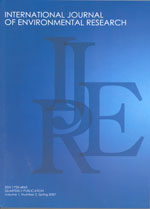
|
International Journal of Environmental Research
University of Tehran
ISSN: 1735-6865
EISSN: 1735-6865
Vol. 1, No. 1, 2007, pp. 42-48
|
 Bioline Code: er07007
Bioline Code: er07007
Full paper language: English
Document type: Research Article
Document available free of charge
|
|
|
International Journal of Environmental Research, Vol. 1, No. 1, 2007, pp. 42-48
| en |
Aplication of Solar Energy for Drying of Sludge from Pharmaceutical Industrial Waste Water and Probable Reuse
Mehrdadi, N., Joshi, S. G., Nasrabadi, T. and Hoveidi, H.
Abstract
Sludge, which is produced as a by-product of all treatment processes, has considerable potential as a fertilizer and soil conditioner. Many authorities now discharge the sludge after treatment directly to agricultural land in liquid form, while some others dewater and dry it first. In either case, with proper marketing, it is generally possible for an authority to earn revenue by this means, although it is rare for the income to cover all the cost involved. In some industrial sludge the total solid concentration may range between 2000-100000 ppm and it is reported that more than 6000 waste water treatment plants use the conventional sludge drying sand bed. An experimental investigation was carried out to assess the efficacy of solar energy for drying of sludge from pharmaceutical industrial waste over a sand bed covered with glass as compared to the conventional sludge drying over a sand bed as well as to reduce environmental pollution .The two drying beds are constructed in 12 cm thick brick wall with cement mortar and has an effective area of 0.5 m 2. On the 0.4 m thick layer of gravel and send the sludge layer from pharmaceutical industry was deposited. The Solar Sludge Drying Sand Bed (SSDSB) reduced drying time by about 25-35% as compared to the Conventional Sludge Drying Sand Bend (CSDSB). The rate of evaporation from the sludge surface and hence the drying was a function of solar radiation. The condensed evaporated water was qualitatively analyzed for probable reuse.
Keywords
Solar energy, Pharmaceutical industry, Industrial sludge, Moisture, Glass cover, Probable reuse, Solids content, Environmental pollution
|
| |
© Copyright 2007 - Graduate Faculty of Environment University of Tehran
Alternative site location: http://ijer.ut.ac.ir/
|
|
